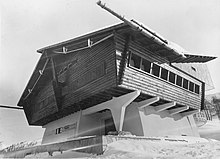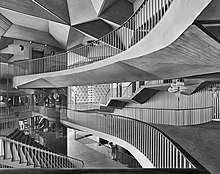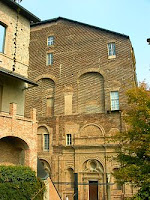A Renaissance man of the mid-20th century
.jpg) |
| Carlo Mollino's talent was nurtured by his engineer father |
Mollino, whose style has been described as an eclectic fusion of the modern and the surreal, was responsible for several notable public buildings, including the Turin Chamber of Commerce and the headquarters of the Horse Riding Club of Turin, as well as several striking private residences and apartment buildings.
He also designed the extraordinary Lago Nero Sled Station, at Sauze d'Oulx, the winter resort 50km (31 miles) north of Turin, and rebuilt the interior of the Teatro Regio opera house in Turin 40 years after a catastrophic fire left little behind the the 18th century facade intact.
Never married in his 68 years, Mollino also had a deeply secretive side, which manifested itself in a number of apartments he kept, the whereabouts of which he disclosed to no one, not even his closest friends and acquaintances.
One of these, in a 19th century villa overlooking the Po river in the centre of Turin, which he preserved as a kind of idealistic shrine, filled with his favourite objects but where it is thought he never actually lived, is now a museum, the Casa Mollino.
Mollino was raised in comfortable surroundings in a 19th-century neo-Gothic villa in Rivoli, about 20km (12 miles) west of Turin. His father, Eugenio, was an important civil engineer who, over the course of his career, built more than 300 buildings in Turin. His father’s work was evidently something that captured the imagination of the young boy, who astonished his teachers at the age of just six by drawing a detailed cross section of a car engine and an illustration of an imaginary town drawn with accurate perspective.
 |
| Mollino's Lago Nero Sled Station, which he called a "flying chalet" |
After graduating, he worked in Eugenio’s studio, from which he pursued his own projects as well as helping his father. The first major work to bear his own stamp was the offices of the Farmers’ Federation in Cuneo, a city about 100km (62 miles) south of Turin, the commission for which was a prize in a competition. The building, which had influences of metaphysical art, immediately identified Mollino as an architect eager to challenge conventions.
At the same time, Mollino was devoting much of his energy to writing. His novel, the Life of Oberon, in which the main character was an architect called Oberon, was published in several instalments in the architecture magazine, Casabella. The novel, seen to be ahead of its time in its protagonist’s description of nature and history as the environments in which architects work, and of the capacity of designs to tell a story, has been interpreted as a personal manifesto.
 |
| Mollino's foyer of the Teatro Regio opera house in Turin |
War interrupted Mollino’s architectural career. He escaped being sent away to fight after a friend gave him a job as a technician at an aeronautical construction company.
Mollino was by then living in an apartment in Turin but left the city because of Allied bombing and returned to live in the family villa in Rivoli. During the war years, he wrote books on photography and skiing, at which he was so proficient he qualified as an instructor. His Il Messaggio dalla Camera Oscura was the first compendium on the history of photography to be published in Italy.
The years after the war were his most productive as as an architect, during which he built the Lago Nero Sled Station on behalf of the car designer Piero Dusio, owner of the Cisitalia company, which resembled a traditional log ski chalet suspended on concrete trusses, the Casa del Sole apartment building in Cervinia, a new Monumental Cemetery on the outskirts of Turin, the interior of Turin’s RAI Auditorium and the Casa Cattaneo, a rationalist villa overlooking Lago Maggiore.
 |
| The dining room from one of Mollino's apartments illustrated his interior design work |
His focus on architectural projects returned in the late 1950s and continued until his death in 1953 from cardiac arrest. By then, he had sealed his legacy with the Chamber of Commerce building in Turin, the design of which allowed for large functional spaces free from columns, and the Teatro Regio opera house, the interior of which saw Mollino create a spectacular elliptical auditorium with a shell-like roof and lightning that resembled icicles, and a labyrinthine foyer based on the enormous subterranean vaults imagined by the 18th century artist, Giovanni Battista Piranesi.
After his death in 1973, it was discovered that he had created in his secret apartment in Via Napione between 1961 and 1970 a collection of different rooms, each lavishly decorated in individual style, one of which was furnished with a boat-shaped bed on a blue carpet, surrounded with symbols of ancient funeral rituals and some of his personal treasures and photographs. It is thought this was the room in which he intended to spend his final hours, although in the event he was working in his studio when he died.
The museum, which can be visited by private appointment, is now maintained by Italian design expert Fulvio Ferrari and his son Napoleone.
 |
| Juvarra's unfinished facade of the Castle of Rivoli |
The town of Rivoli, where Mollino grew up, is notable for the Castle of Rivoli, probably built in the 9th–10th centuries and acquired by the House of Savoy in the 11th century. In 1273 King Edward I of England visited the castle en route from the Crusades and the castle was the first place of public veneration of the Shroud of Turin, the length of cloth claimed to have been wrapped around the body of Christ after the crucifixion. Work on the current Baroque structure began in the 17th century and was redesigned but never finished by the architect Filippo Juvarra in the 18th century. Since the late 20th century it has been home to a permanent collection of 20th-century Italian art.
 |
| Mollino's elliptical auditorium at the Teatro Regio Torino, with its icicle lighting |
The Teatro Regio Torino, which was Mollino’s last major work, can be found in Piazza Castello close to the Palazzo Reale in the centre of Turin. The theatre has had of a chequered history. Inaugurated in 1740, it was closed by royal decree in 1792 then reopened with the French occupation of Turin during the early 19th century, first as the Teatro Nazionale and then the Teatro Imperiale before its original name was reinstated with the fall of Napoleon in 1814. It endured several financial crises in the late 1800s but limped into the 20th century only to be burnt down in the catastrophic fire in 1936. It remained dark for 37 years until reopening in 1973. The rebuilt theatre, with Mollino’s striking contemporary interior design hidden behind the original facade, was inaugurated with a production of Verdi's I vespri siciliani directed by Maria Callas and Giuseppe Di Stefano.
Also on this day:
1895: The birth of silent movie star Rudolph Valentino
1963: The birth of ballerina Alessandra Ferri
No comments:
Post a Comment